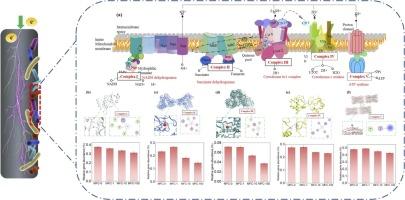Mechanistic insights into the response of oxygen reducing biocathode to Ni2+: microbial activity and electron transfer behavior
IF 11.3
1区 环境科学与生态学
Q1 ENGINEERING, ENVIRONMENTAL
引用次数: 0
Abstract
Heavy metals affect the electrochemical activity of microorganisms in bioelectrochemical systems. However, effects of heavy metals on microbial viability and extracellular electron transfer of oxygen reducing biocathodes remains elusive. This study indicated that the impact of Ni2+ shock was concentration-dependent. At 1 mg L–1, current density and electrochemical performance improved, with the highest live cell proportion (73.2%). Conversely, higher concentrations (10 and 100 mg L–1) showed negative effects, with increasing cell death and biocathode damage. Functional groups (i.e. carbonyl C=O, N-H, C-H, and C-O-C), and proteins, humic acid of LB-EPS were confirmed to bind with Ni2+, preventing the penetration into cells. Increased Ni2+ levels intensified interactions with biofilm functional groups, reducing direct electron transfer between oxygen reducing biofilm and cathode. Ni2+ shock altered the structure and microbial richness of the cathode biofilms, decreasing electron transfer gene abundance (e.g., nikA, sodN) and increasing heavy metal resistance genes (e.g., czcB, TC.HME) at higher Ni2+ concentrations. Molecular docking showed Ni2+ interacted variably with electron transfer enzymes, strongly binding to succinate dehydrogenase and cytochrome bc1 complex, affecting enzyme activity and metabolism. This research enhanced understanding of biofilm response to Ni2+ shock and provided insights for improving performance in heavy metal wastewater.

氧还原生物阴极对Ni2+反应的机理:微生物活性和电子转移行为
重金属影响生物电化学系统中微生物的电化学活性。然而,重金属对微生物活力和氧还原生物阴极胞外电子转移的影响尚不清楚。本研究表明,Ni2+休克的影响是浓度依赖性的。在1 mg L-1时,电流密度和电化学性能得到改善,活电池比例最高(73.2%)。相反,较高浓度(10和100 mg L-1)表现出负面影响,增加细胞死亡和生物阴极损伤。证实LB-EPS的官能团(羰基C=O、N-H、C- h、C-O-C)、蛋白质、腐植酸与Ni2+结合,阻止Ni2+渗入细胞。增加的Ni2+水平增强了与生物膜官能团的相互作用,减少了氧还原生物膜与阴极之间的直接电子转移。Ni2+冲击改变了阴极生物膜的结构和微生物丰富度,在较高的Ni2+浓度下,电子转移基因(如nikA, sodN)丰度降低,重金属抗性基因(如czcB, TC.HME)增加。分子对接表明,Ni2+与电子转移酶的相互作用变化很大,与琥珀酸脱氢酶和细胞色素bc1复合物结合强烈,影响酶的活性和代谢。本研究提高了生物膜对Ni2+冲击反应的认识,为提高生物膜处理重金属废水的性能提供了新的思路。
本文章由计算机程序翻译,如有差异,请以英文原文为准。
求助全文
约1分钟内获得全文
求助全文
来源期刊

Journal of Hazardous Materials
工程技术-工程:环境
CiteScore
25.40
自引率
5.90%
发文量
3059
审稿时长
58 days
期刊介绍:
The Journal of Hazardous Materials serves as a global platform for promoting cutting-edge research in the field of Environmental Science and Engineering. Our publication features a wide range of articles, including full-length research papers, review articles, and perspectives, with the aim of enhancing our understanding of the dangers and risks associated with various materials concerning public health and the environment. It is important to note that the term "environmental contaminants" refers specifically to substances that pose hazardous effects through contamination, while excluding those that do not have such impacts on the environment or human health. Moreover, we emphasize the distinction between wastes and hazardous materials in order to provide further clarity on the scope of the journal. We have a keen interest in exploring specific compounds and microbial agents that have adverse effects on the environment.
 求助内容:
求助内容: 应助结果提醒方式:
应助结果提醒方式:


